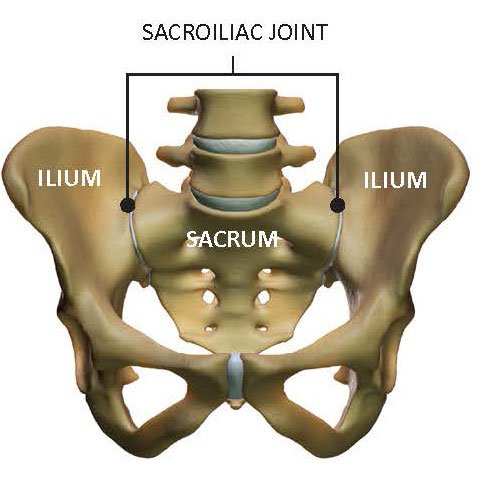
iFuse
Studies show that sacroiliac (SI) joint disorders are a challenging condition affecting up to 25% of patients with low back pain.1
The SI joint is located in the pelvis; it links the iliac bones (pelvis) to the sacrum (lowest part of the spine above the tailbone).

Like any other joint in the body, the SI joint can be injured and/or become degenerative.
When this happens, people can feel pain in their buttock and sometimes higher on the skeleton (bones forming the central axis of the body: the skull, the vertebral column, the ribs and the sternum). This is especially true with lifting, running, walking or even sleeping on the involved side.
It is important to note that on occasion, patients who have not had symptomatic relief from lumbar spine surgery may actually have had other issues to begin with. This could include the SI joint, the hip, the spine, or any combination of these three pain generators.
Diagnosis of the SI Joint as a Source of Symptoms
The good news is that your surgeon can now distinguish between low back symptoms arising from the lumbar portion of the spine and the SI joint. A variety of tests performed during physical examination may help determine whether the SI joint is a source of your symptoms. In addition, X-rays, CT-scan, and/or MRI are helpful in the diagnosis of SI joint-related problems. It is also important to remember that more than one condition (like a disc problem) can coexist with SI joint disorders.
An often relied upon method to accurately determine whether the SI joint is the cause of your low back symptoms is to inject the SI joint with painkillers. Your surgeon will deliver the injection with either fluoroscopic or CT guidance to verify accurate placement of the needle in the SI joint. If your symptoms are decreased by at least 75%, it may be surmised that the SI joint is either the source, or a major contributor, to your low back pain.3 If your symptoms do not improve after SI joint injection, it is less likely that a problem with your SI joint is the cause of your low back symptoms.
Conservative Therapy
Once the SI joint is confirmed as a source of your symptoms, treatment can begin. Some patients respond to physical therapy, chiropractic manipulations, use of oral medications, as well as injection therapy. The anti-inflammatory effect of SI joint injections is not permanent and does not stabilize the SI joint.4
Intermittent use of a pelvic belt may provide symptom relief as well. These treatments are performed repetitively and frequently symptom improvement using these therapies is only temporary. Once non-surgical treatment options have been tried and do not provide relief, your surgeon may consider other options, including surgery.
SI Joint Fusion with the iFuse Implant System
Sacroiliac joint fusion is a surgical procedure intended to stabilize the joint and eliminate motion.
The iFuse Implant System is intended for use in patients with certain SI joint disorders including sacroiliac joint disruptions and degenerative sacroiliitis. This system uses small titanium implants placed across the sacroiliac joint to stabilize and fuse it.
As with all surgical procedures and permanent implants, there are risks and considerations associated with surgery and use of the iFuse Implant. You should discuss these risks and considerations with your physician before deciding if this treatment option is right for you.
iFuse Benefits
- Minimally invasive surgical (MIS) approach
- Triangular implant profile minimizes rotation and an interference fit minimizes micromotion
- Porous plasma titanium spray coating
- Designed specifically to stabilize and fuse the heavily loaded SI joint
- Rigid titanium constructs and large implant surface area provide stability
- No conflicts with lumbar fusion devices
During Surgery
SI joint fusion is performed in an operating room, with either general or spinal anesthesia. You will be lying face down while your surgeon uses a specially designed system to guide the instruments that prepare the bone and insert the implants. Both the surgical technique and the iFuse Implant System are designed to offer the maximum protection to your surrounding tissues.
The entire procedure is performed through a small incision (approximately 2-3 cm long), along the side of your buttock. During the procedure, X-rays provide your surgeon with live imaging to enable proper placement of the implants. Normally, three implants are used, depending on your size.
The procedure typically takes less than one hour. You may feel comfortable enough to return home the same day of surgery or perhaps the morning after. Your surgeon will make this decision based on your post-surgical status.
Is iFuse Right for You?
Dr. Matthew Schreckinger is trained in the latest minimally invasive surgical (MIS) techniques, including use of the iFuse Implant System® from SI-BONE®, Inc., a medical device company pioneering MIS sacroiliac (SI) joint treatment. To make an appointment with Dr. Schreckinger, please see his profile in our Find a Doctor tool.
References
- Cohen, Steven P. Sacroiliac Joint Pain: A Comprehensive Review of Anatomy, Diagnosis, and Treatment. Anesth Analg 2005; 101:1440-1453.
- Katz, Victor, Jerome Schofferman, and James Reynolds. “The Sacroiliac Joint: a Potential Cause of Pain After Lumbar Fusion to the Sacrum.” Journal of Spinal Disorders & Techniques 16, no. 1 (February 2003): 96–99
- Katz, Victor, Jerome Schofferman, and James Reynolds. “The Sacroiliac Joint: a Potential Cause of Pain After Lumbar Fusion to the Sacrum.” Journal of Spinal Disorders & Techniques 16, no. 1 (February 2003): 96–99
- Zelle, Boris, et al. Sacroiliac Joint Dysfunction, Evaluation and Management. Clinical Journal of Pain, 2005 Sept/Oct 21(5): 446-455
